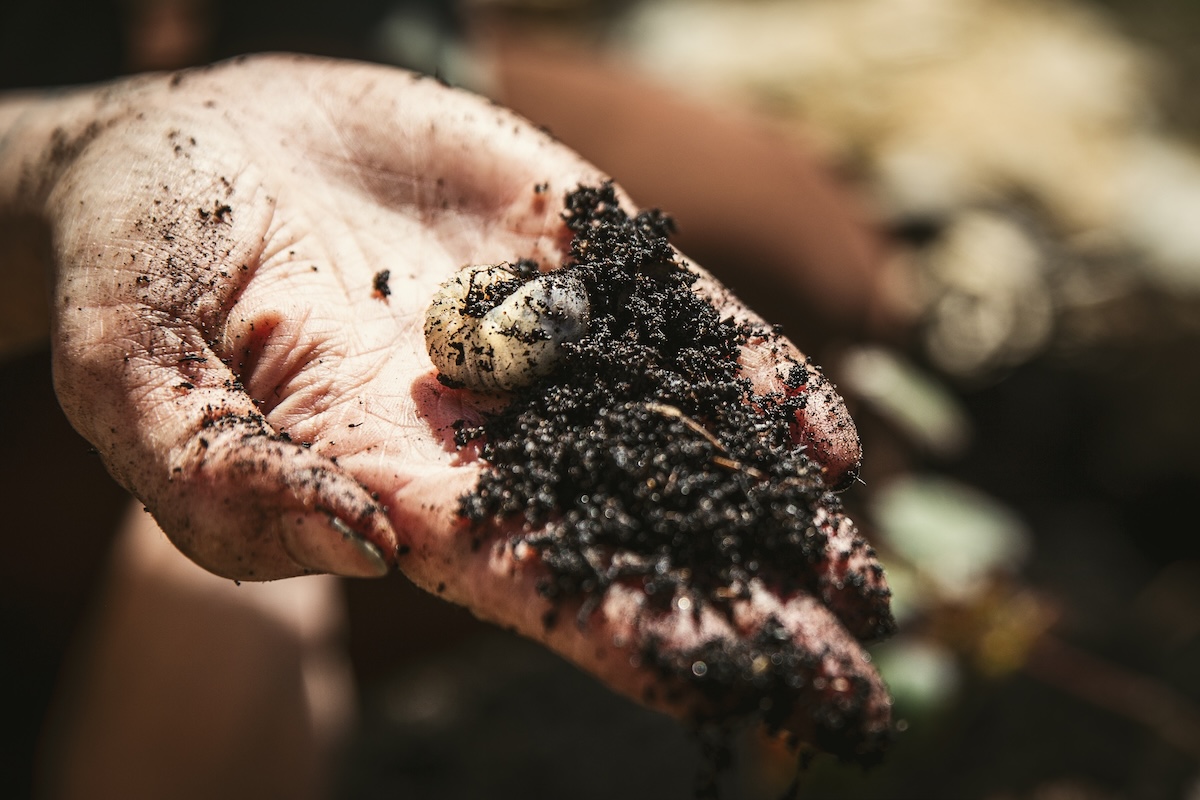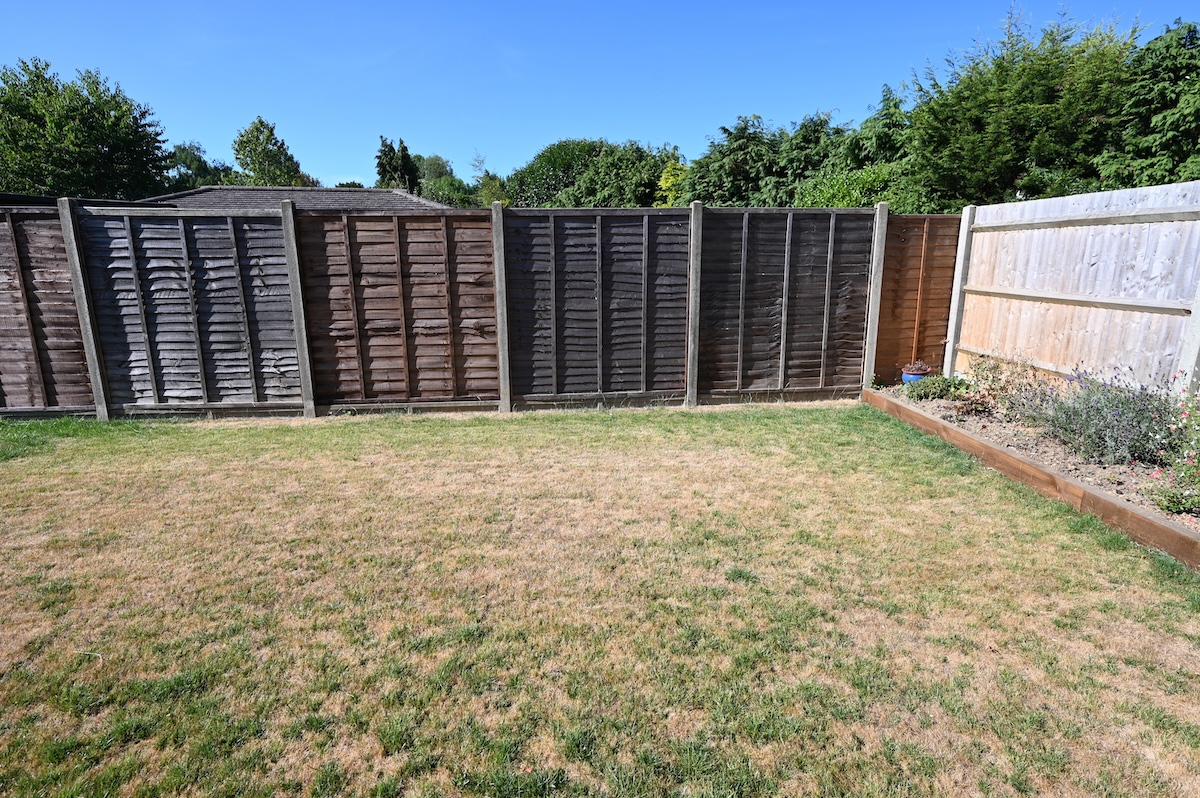

We may earn revenue from the products available on this page and participate in affiliate programs. Learn More ›
You won’t see grubs coming, and by the time they make their presence known, you could have a full-blown infestation on your hands. Lawn-loving larvae of various beetles, these tiny trespassers lurk beneath the surface of your grass, feasting on the roots and causing unsightly brown patches. If you want grass to thrive in your yard, you have to learn how to get rid of grubs first.
Tools & Materials
Bobvila.com may earn a commission from purchases made through these links.
4 Ways to Get Rid of Grubs
Nearly all lawns have a few grubs, but they rarely cause trouble unless their population soars.
Before treating your lawn for grubs, the first step is to make sure that your brown grass is being caused by grub damage vs. fungus, overwatering, disease, or other pests or challenges. To determine if grubs are the culprit, remove a square foot of sod, about 3 inches deep, from the center of a brown patch. Sift through it and look for milky white C-shaped larvae. The insects can vary in length from ½ inch to 1 inch, depending on the species of beetle they will eventually become.
If you find 10 or more grubs in the sod you removed, it’s time to formulate a treatment plan. We’ve put together the best ways, both natural and chemical, to deter and/or kill grubs.
1. Introduce Nematodes
If you’re looking for a natural way to rid your lawn of grubs, consider introducing beneficial nematodes to your lawn. Nematodes (typically of the Heterorhabditis bacteriophora, or Hb, variety) are microscopic parasites that invade grubs’ bodies, releasing bacteria that multiply and ultimately kill the host grub.
It can take up to 3 years for nematodes to establish a colony large enough to eradicate a large population of grubs, but going this route means you won’t have to treat your lawn with chemicals. If you’re using nematodes to control grubs in your yard, keep in mind the following guidelines:
- Order nematodes from a reputable source; they are living organisms that must be transported with care (usually refrigerated) and applied soon after they arrive.
- Always follow the nematode producer’s instructions for application.
- Know what you’re buying: Certain species of nematode only control certain species of grub.
- Nematodes may need to be applied when the species of grubs they control are active in the soil.
- While the nematodes are getting established, keep the soil moist and don’t let it go dry.
- Apply nematodes on an overcast day, or in the early morning or evening, as exposure to light or heat can kill them.
- To control an infestation, nematodes may need to be applied every 2 weeks until the infestation subsides. If using nematodes preventively, apply 2 to 3 times a season.
2. Apply Milky Spore
Available in powder form at a garden center or at online retailers, Bacillus popilliae spores, sold as milky spore, infect grubs with a fatal disease known as milky disease. As they die, the grubs release yet more spores into the soil, which are then ingested by other grubs. Milky spore is organic and won’t harm your lawn, but it’s deadly to grubs.
Like nematodes, milky spore isn’t a quick fix. It takes a few years to develop enough of the beneficial spores to rid the yard of grubs. But once established in the soil, the “disease” effectively wards off grubs.
There are, however, some caveats. Milky spore is effective only on grubs of the Japanese beetle, which has spread throughout most of the eastern and central states but isn’t yet common in the West. If your brown patches are caused by some other grub, milky spore won’t help. Making things even trickier, it can be tough to tell one grub from another. Hairs on the hind end of the abdomen of a Japanese beetle grub form a distinctive V-shape, but you need a hand lens to see them. As well, milky spore is less effective in colder climates where spring soils aren’t warm enough for the disease to thrive. Finally, recent studies have suggested that milky spore may not be as effective at controlling grubs as initially thought. But if you’re certain you’re dealing with grubs of the Japanese beetle, milky spore can be the way to go.

Tried-and-True Advice
Milky spore is my go-to for natural lawn grub control, but if you happen to have backyard chickens, you may also want to enlist their help.
While I generally practice no-till gardening, if I ever encounter grub issues in my veggie beds, I work the soil a bit to expose the grubs and then bring in my chickens.
Chickens are excellent garden helpers for controlling soil-dwelling pests and they gobble up any grub they see and dig up the soil for more. If you don’t have chickens but keep bird feeders, wild birds may help by foraging for exposed grubs too.
—Lauren Landers, Contributing Writer
3. Don’t Fight Drought

Beetle eggs need moisture to survive, so if you have a grub problem, you can try drying out your lawn to make it as inhospitable as possible.
If you experience drought conditions during the summer months, when adult beetles lay their eggs, take advantage of the dry conditions by making the conscious decision not to water your lawn for 3 or 4 weeks to further dry out the soil. The eggs will eventually die, which will reduce next year’s crop of larvae.
Your lawn will dry out, too, but as long as your grass is in good condition, it should spring back to health when you resume watering.
4. Chemical Control
Chemical-based grub control can be very effective, but keep in mind that these chemicals can kill both beneficial insects and grubs. Take care to understand the manufacturer’s instructions for safe use, and be sure to consider the risks that chemical lawn treatments can pose for children and pets.
Generally speaking, chemical treatments fall into two categories: curative and preventive.
- Curatives are designed to kill immature larvae, should be applied in late summer or early fall when young grubs are actively feeding on grass roots. Look for a product that contains trichlorfon, such as Dylox. Note that curatives do not affect grubs that have already developed into pupae.
- Preventatives: If you’ve had a grub problem in the past, or if you’ve spotted telltale brown patches in your neighbor’s yard, applying a preventive grub-control product will reduce the risk of your lawn becoming infested. These treatments are typically applied in late spring/early summer. While they will stop the next generation of grubs, they have little effect on any young grubs that are currently chomping away in your grass. Look for preventive products that contain imidacloprid (such as Merit).
FAQ
Grubs end up in your lawn because beetles laid their eggs there, and those beetles probably came to your yard in search of food and a place to lay their eggs. Many beetles are voracious herbivores, so they’re drawn by your healthy grass and your carefully tended plants and trees. They’re also attracted by light and moisture—many beetles require soft, damp soil to lay their eggs. You can make your property less attractive by reducing light around your house at night and limiting watering during late spring through early summer when the females are laying eggs.
Certainly, but usually not without help. After eliminating the infestation, rake up any dead grass, loosen the soil, and sow some grass seed. Warm-season varieties tend to be more grub-tolerant; of the cool-season grasses, tall fescue is a good option. To help your grass withstand grubs, encourage a stronger root system by mowing regularly (but not too low); watering deeply, but less frequently; and regularly applying lawn fertilizers.
If you’re using nematodes, apply 2 to 3 times per year. Preventive insecticides, on the other hand, are usually applied once a year, in late spring/early summer. (Some homeowners skip this application if they haven’t had recent infestations.) For active infestations, apply a curative grub killer either in very early spring (before the grubs pupate in early May) or in late summer/early fall, when they are actively feeding. Curative treatments can take days or weeks to work, and they’re less effective as grubs move deeper into the soil for winter. Generally, preventive treatments are less toxic and better at reducing grub populations. But if you’re trying to save your lawn from a serious infestation, hit it with a curative insecticide and then follow up in the spring with a preventive.
